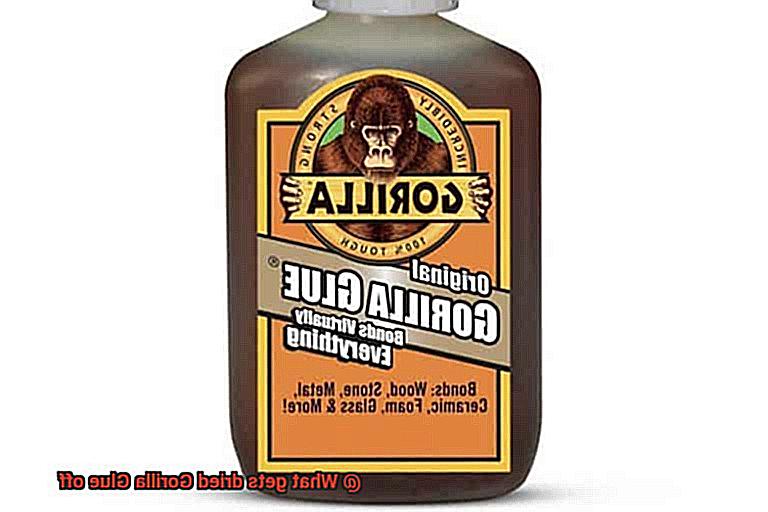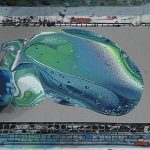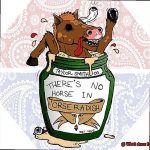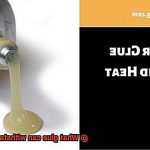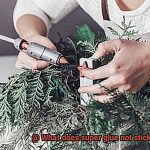We’ve all been in that sticky situation – a spilled glob of Gorilla Glue or a DIY repair gone wrong, leaving you with a stubborn dried mess. Don’t panic. This super-strong adhesive may seem like an unbeatable foe, but fear not. In this article, we’re diving into the world of effective techniques to answer the burning question: What’s the secret to getting dried Gorilla Glue off?
Whether it’s your beloved countertops, cherished fabrics, or even your trusty tools, we’ve got you covered with tried-and-true methods to banish those tenacious Gorilla Glue stains for good.
So grab your cleaning gear and let’s get down to business.
What gets dried Gorilla Glue off?
Contents
- 1 What gets dried Gorilla Glue off?
- 2 What is Gorilla Glue?
- 3 How Does Gorilla Glue Work?
- 4 Removing Dried Gorilla Glue with Acetone
- 5 Removing Dried Gorilla Glue with Isopropyl Alcohol
- 6 Mechanical Methods for Removing Dried Gorilla Glue
- 7 Caution When Removing Dried Gorilla Glue
- 8 Testing Cleaning Methods Before Applying to the Entire Surface
- 9 Conclusion

Method 1: Scrape It Off
If your surface can handle a gentle scrape, this method is perfect. Grab a plastic scraper or even use your fingernail (carefully.) and chip away at the dried glue. Take it slow and steady to avoid any harm to the underlying surface.
Method 2: Soak in Warm Soapy Water
Fabrics and garments require some extra TLC. Begin by mixing warm water with mild liquid dish soap. Let the affected area soak in this solution for about 15-20 minutes, allowing the adhesive to soften. Then, grab a soft-bristle brush and gently scrub away the loosened glue residue. Rinse thoroughly and let it air dry.
Method 3: Acetone – The Magic Solvent
When it comes to dissolving dried Gorilla Glue, acetone is your superhero sidekick. But be cautious. It can damage certain surfaces, so test a small hidden spot first. For hard surfaces like glass, metal, or ceramics, saturate a cloth with acetone and apply it directly onto the glue. Let it sit for a few minutes to soften, then gently scrape off the adhesive.
Method 4: Vinegar Power
If you prefer a safer alternative, vinegar is your trusty companion. Soak a cloth or cotton ball in white vinegar and apply it directly to the glue. Give it around 20 minutes to work its magic, then carefully scrape away the softened glue. Rinse the area thoroughly afterward.
Method 5: Heat and Oil Combo
For those sticky situations on metal surfaces, here’s a winning combo – heat and oil. Grab a hairdryer
What is Gorilla Glue?
Its versatility and remarkable strength make it a reliable choice for bonding almost any material.
At the heart of Gorilla Glue’s success is its exceptional bonding strength. Whether you’re working with wood, metal, stone, ceramic, fabric, foam, or glass, Gorilla Glue creates reliable and long-lasting bonds that can withstand heavy loads and extreme conditions.
This adhesive’s power comes from its unique formula, which includes polyurethane. When exposed to moisture, Gorilla Glue reacts to create a robust bond that expands as it cures. The expansion fills gaps and enhances the overall strength of the bond, ensuring a durable connection.
Gorilla Glue offers different variations to suit various needs. The original formula is a liquid adhesive that requires moisture to activate its bonding properties. For projects where aesthetics are important, a clear glue is available that dries transparently. And if you’re looking for faster project completion, there’s a fast-drying glue option.
Once cured, Gorilla Glue remains resistant to water and temperature variations. It can endure both hot and cold temperatures without compromising its integrity, making it suitable for indoor and outdoor applications.
While Gorilla Glue provides exceptional bonding strength, it requires careful usage. It expands during curing, so applying it sparingly and clamping materials being bonded is essential to avoid excessive foaming. Following the manufacturer’s instructions and taking necessary safety precautions, such as wearing gloves and working in a well-ventilated area, is crucial.

When removing dried Gorilla Glue, options include using acetone or isopropyl alcohol. Gently applying acetone with a clean cloth or cotton ball can break down the glue’s chemical structure. Isopropyl alcohol works similarly by dissolving the adhesive properties. Mechanical methods like scraping or sanding can be used for hard surfaces, but caution is necessary to avoid damage.
How Does Gorilla Glue Work?
Gorilla Glue is an adhesive that is widely recognized for its exceptional strength and versatility. Its remarkable bonding capabilities are attributed to a chemical reaction known as cross-linking, which occurs when the glue comes into contact with moisture.
Composed of polyurethane, Gorilla Glue contains polymers that react with water or moisture in the air. This reaction triggers the cross-linking process, during which the polyurethane molecules form robust bonds with one another. The result is a durable and waterproof adhesive that can adhere to various surfaces, including wood, metal, stone, and ceramics.
An outstanding characteristic of Gorilla Glue is its expansion ability. As it cures, the glue expands, enabling it to fill gaps and create a tight bond between surfaces. This unique feature ensures that even a small amount of Gorilla Glue can yield exceptional results.
To achieve optimal adhesion, proper surface preparation is vital. Before applying the glue, the surfaces should be clean, dry, and free from any dust or grease. This allows for maximum contact between the glue and the materials being bonded.
Once applied, Gorilla Glue requires pressure to activate the cross-linking process fully. Applying pressure helps the glue spread evenly and establish strong contact between the surfaces. Clamps or heavy objects can be utilized to apply adequate pressure while the glue cures.
The curing time for Gorilla Glue varies depending on factors such as temperature and humidity levels. While it typically takes approximately 24 hours for the glue to reach maximum strength, allowing at least 72 hours for a full cure is recommended.
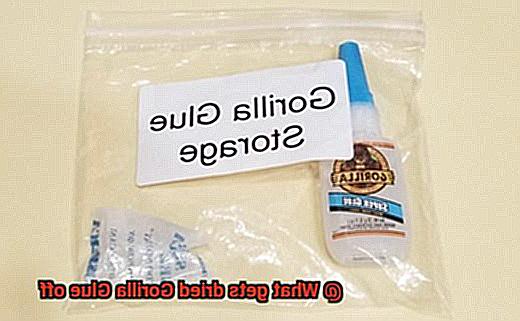
Gorilla Glue’s ability to bond both porous and non-porous surfaces makes it suitable for an extensive range of applications. However, it should not be used on polyethylene or polypropylene plastics.
Removing Dried Gorilla Glue with Acetone
Acetone, a commonly used solvent, is highly effective in removing dried Gorilla Glue from various surfaces. This powerful chemical breaks down the adhesive properties of the glue, making it easier to remove. However, it is important to exercise caution when using acetone as it can also damage certain materials.
To safely remove dried Gorilla Glue with acetone, follow these steps:
- Prepare your workspace: Work in a well-ventilated area to avoid inhaling the strong fumes of acetone. Additionally, wear gloves to protect your skin from direct contact with the chemical.
- Apply acetone: Pour a small amount of acetone onto a clean cloth or cotton ball. Gently dab the affected area with the acetone-soaked cloth, ensuring that the entire glue stain is covered. Allow the acetone to sit on the glue for a few minutes, giving it time to break down the adhesive bonds.
- Scrape away the softened glue: Using a scraper or blunt tool, gently scrape away the softened glue. Be cautious not to apply excessive pressure or use sharp tools that may damage the underlying surface. If necessary, repeat the process of applying acetone and scraping until all traces of dried Gorilla Glue are removed.
- Test on inconspicuous areas: Before applying acetone to any material, it is advisable to test it on a small inconspicuous area first. This will determine if any damage or discoloration occurs. Materials such as plastics, certain fabrics, and painted surfaces may react negatively to acetone, so consider alternative methods for these cases.
- Clean the area: After successfully removing the dried Gorilla Glue with acetone, thoroughly clean the affected area to eliminate any residue or traces of acetone that may remain. Use mild detergent or soap and warm water to clean the surface, followed by a rinse to ensure complete removal of all chemicals.
It is important to note that there are commercial adhesive removers available that contain acetone as an active ingredient. These products, often in spray form, can be a convenient option for removing dried Gorilla Glue from larger areas or surfaces that are difficult to reach.
Removing Dried Gorilla Glue with Isopropyl Alcohol
Removing dried Gorilla Glue from a surface using isopropyl alcohol is a simple and effective process that can restore your surfaces to their original condition. Isopropyl alcohol, also known as rubbing alcohol, has strong adhesive-dissolving properties that make it an excellent choice for removing dried glue.
To begin, gather the necessary materials: a clean cloth or sponge, isopropyl alcohol, and water. Working in a well-ventilated area and wearing gloves to protect your skin is important.
Start by dampening the cloth or sponge with a small amount of isopropyl alcohol. It’s crucial not to soak it too much, as excessive liquid can damage certain surfaces. The next step is to gently rub the cloth or sponge onto the dried Gorilla Glue in a circular motion. Applying slight pressure helps loosen the glue from the surface. As you continue rubbing, you may notice the glue starting to dissolve and become softer.
For particularly stubborn or thick glue, let the isopropyl alcohol sit on it for a few minutes before rubbing again. This gives the alcohol more time to break down the adhesive bonds. Persistence is key—the more you work on the glue, the more it will come off.
Once you have successfully removed the dried Gorilla Glue, rinse the area with water to remove any residue of both the glue and the alcohol. This step ensures that your surface is left clean and free from any remaining traces.
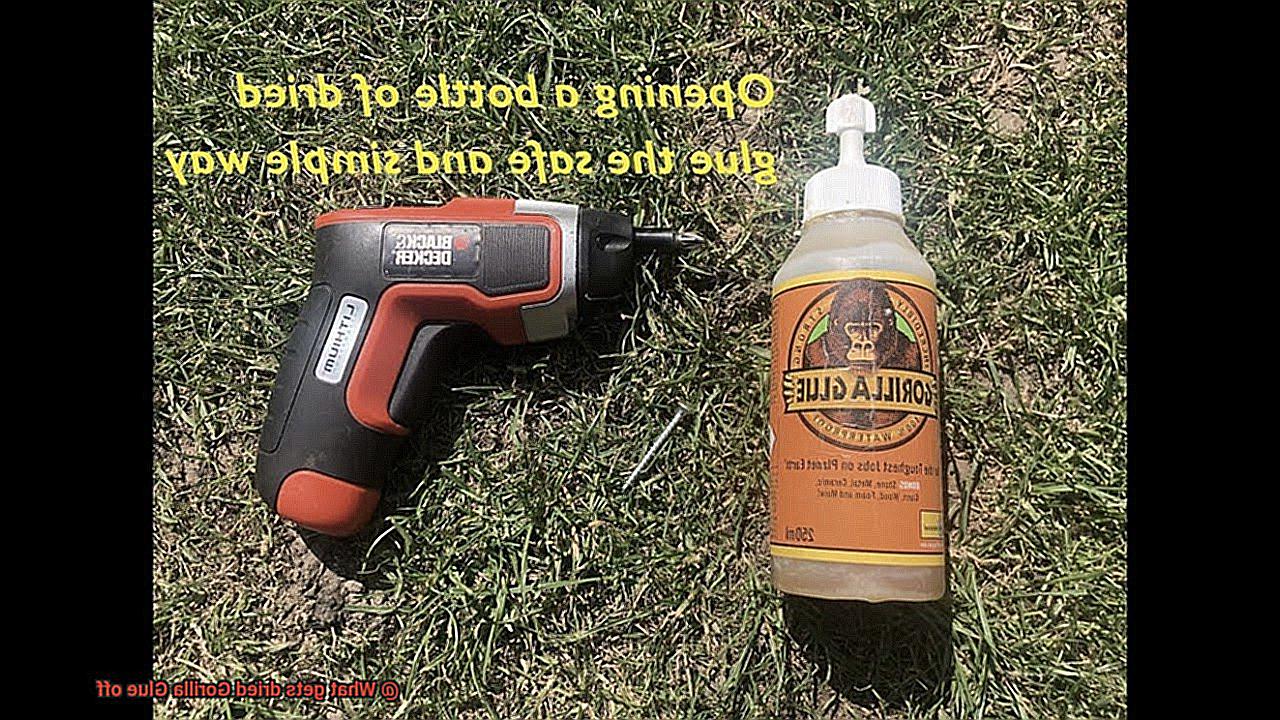
Here are a few additional tips for using isopropyl alcohol to remove dried Gorilla Glue:
- Test it first: Before using isopropyl alcohol on a visible surface, conduct a test on a small, inconspicuous area to ensure that it does not cause any damage or discoloration.
- Work in small sections: If you are removing Gorilla Glue from a large area, work in small sections to ensure that you are able to remove all of the glue before the alcohol evaporates.
- Use a scraper if necessary: If the glue is particularly stubborn, you can use a plastic scraper or blunt tool to gently scrape it off the surface. Be careful not to scratch the surface in the process.
- Repeat if needed: If there is still some glue residue left after the first attempt, repeat the process until the surface is completely clean.
Mechanical Methods for Removing Dried Gorilla Glue
Mechanical methods for removing dried Gorilla Glue offer a hands-on approach to tackle those stubborn adhesive blobs. Imagine yourself armed with a trusty scraper or putty knife, ready to go toe-to-toe with the glue.
Before you begin, consider the surface you’re working on. Delicate or highly finished materials might not be the best candidates for mechanical removal. Safety always comes first.
Let’s dive into the nitty-gritty of scraping. Gently insert the edge of your scraper under the dried glue and apply controlled pressure to lift it off. Slow and steady wins the race here—no need to go Hulk-smash. Work in small sections, scraping away until every last bit of glue is gone.
But what if the Gorilla Glue refuses to budge? That’s when sanding comes into play. Start with coarse-grit sandpaper to remove the bulk of the glue, then switch to a finer grit to smooth things out. Remember, a gentle touch is crucial here—we don’t want any collateral damage.
Don’t forget your safety gear. Ventilation is crucial, so work in a well-ventilated area. And don’t forget to rock those safety goggles and dust mask like a boss to protect against flying debris.
Now, here’s the catch: mechanical methods may not always yield a flawless finish. Sometimes, a slight residue or stain may remain, especially on porous surfaces. If that happens, you may need to explore other cleaning methods or seek professional help.
Caution When Removing Dried Gorilla Glue
When it comes to removing dried Gorilla Glue, caution is key. This incredibly strong adhesive can be a real challenge to remove, and if not approached with care, you risk damaging the surface or causing harm to yourself. Here are some important reasons why you should exercise caution when removing dried Gorilla Glue:
- Difficulty of Removal: Once Gorilla Glue has dried, it becomes extremely difficult to remove. Its strong bond can withstand a lot of force, making it resistant to mechanical removal methods. Therefore, it’s important to approach the removal process with patience and care.
- Follow Manufacturer’s Instructions: Before attempting to remove dried Gorilla Glue, make sure to read and follow the instructions provided by the manufacturer. They may have specific recommendations or precautions that you need to be aware of in order to safely remove the glue without causing damage.
- Ventilation and Protective Gear: Working in a well-ventilated area is crucial when removing dried Gorilla Glue. The removal process can release fumes that may be harmful if inhaled in large quantities. Additionally, wearing protective gloves and safety goggles is highly recommended to protect your skin and eyes from any potential hazards.
- Proper Tools and Techniques: Using the right tools and techniques is essential when removing dried Gorilla Glue. Scrubbing vigorously or using abrasive materials can cause damage to the surface you’re working on. Instead, opt for gentle rubbing motions and non-abrasive materials like clean cloths or cotton swabs.
- Flammability of Solvents: One common method for removing dried Gorilla Glue is by using acetone or nail polish remover. However, it’s important to note that these substances are highly flammable. Take precautionary measures while using them, such as working in a well-ventilated area away from open flames or sparks.
- Test on Small Area: Before applying any solvent or cleaning agent, it’s crucial to test it on a small, inconspicuous area of the surface. This will ensure that it does not cause any damage or discoloration before you proceed with the removal process.
- Patience is Key: Removing dried Gorilla Glue can take time. Solvents may need some time to soften the glue, so be patient and allow them to work their magic. Avoid rushing or using excessive force, as this can lead to unintended damage.
- Seek Professional Assistance if Needed: If all else fails or if you’re unsure about the best approach, it may be necessary to consult a professional or seek advice from the manufacturer of the surface or object on which the Gorilla Glue has dried. They may have specialized knowledge or techniques that can help you safely remove the glue without causing damage.
Testing Cleaning Methods Before Applying to the Entire Surface
Testing cleaning methods before applying them to the entire surface is a vital step in removing dried Gorilla Glue without causing damage. Here’s why it’s important:
- Different materials require different methods: Gorilla Glue can adhere to various surfaces like glass, fabric, or wood. Each material may need a specific cleaning method, so it’s crucial to choose the most suitable approach for your case.
- Prevent further damage: Nobody wants to worsen the situation, right? By testing a small area first, you can observe how the material reacts to the cleaning agent and check for any adverse effects like discoloration or damage. It’s better to be safe than sorry.
- Conduct a hidden spot test: Find a small, inconspicuous area on the surface (we don’t want to ruin the whole thing.) and apply a small amount of the cleaning agent. Gently rub it on the glue residue and observe the material’s reaction. If there are no negative effects, proceed with confidence.
- Consider the material: Not all cleaning methods work well on every material. For instance, acetone or nail polish remover might work wonders on glass but could cause damage or discoloration on fabrics or painted surfaces. Always consider the material you’re working with and choose a cleaning method accordingly.
- Time and effort considerations: Some cleaning methods provide quick results, while others require more time and effort. It’s essential to weigh the pros and cons of each method and choose what suits your needs best.
QYmZSDjLQ9A” >
Conclusion
In conclusion, banishing dried Gorilla Glue can be a formidable challenge. But fear not, for with the right strategies and precautions, you can reclaim pristine surfaces once more. Whether you opt to scrape it away, immerse it in warm soapy water, employ the power of acetone or vinegar, or embrace the dynamic duo of heat and oil, an array of methods exists to tackle this sticky predicament.
When wielding solvents like acetone or isopropyl alcohol, ensure you toil in a well-ventilated space and don protective gloves. Prioritize testing these solvents on a discreet nook before unleashing them upon your entire surface; this precautionary measure will shield against any damage or unsightly discoloration.
Mechanical methods such as scraping or sanding wield effectiveness on robust surfaces but necessitate caution to prevent inadvertent harm. Proceed with deliberate care and gentleness when employing these techniques.
Before embarking on a full-scale cleaning assault, conduct an undercover spot test. This covert operation will determine if your chosen method harmonizes with the material at hand and prevents further harm from befalling your beloved surface.
Remember that patience reigns supreme when vanquishing dried Gorilla Glue. Solvents require time to soften the glue’s grip; thus, resist the urge to hasten the process or apply excessive force.
Should all else falter or if uncertainty clouds your judgment, seek professional assistance or consult with the manufacturer of your surface or object. Their expertise may prove invaluable in navigating this sticky conundrum.
By adhering to these tips and techniques, you can bid farewell to dried Gorilla Glue and resurrect your surfaces’ former glory. Just remember: proceed with caution, select the method best suited for your unique situation, and always test before committing fully.

